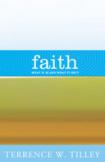Living It
It is not easy to explain faith, nor is it easy to write about it. But Terrence Tilley has done so in a fine manner in this small book, which unpacks various aspects and nuances of faith. It is always wonderful to come across an accessible book that can be used with those beginning to explore their life of faith, and also with those starting their study of theology. Tilley’s work will also be useful for those of us who are not new at pondering what it means to be a person of faith.
Tilley, a professor of Catholic theology and department chair at Fordham University, is correct when he states that faith is a powerful human reality that is often ignored and misunderstood in our public discourse. It is easy to state that one has faith, but that is usually where the conversation ends. This book explores misunderstandings about faith, various ways to define faith, what it means to express one’s faith in public, how one lives faith and finally how it is possible to justify the faith one professes.
I found the first chapter, on misunderstanding faith, to be quite relevant, especially since so many people today are taking it upon themselves to judge (and often condemn) the faith of others in their midst. The reader needs to be reminded that “faith always involves risk. Blind faith is irrational risk.” Tilley clearly explains that faith is not the same as morality, nor is it the same as hope. Neither is all faith connected to religious beliefs or expressions, for as Tilley states, “people without religious faith also do have faith.” Those with “religious faith” will greatly benefit from Tilley’s explanation of scientific materialism, Freud’s critique of religion as illusion, humanism and universalism—if for no other reason than to be able to respond to such critiques.
When discussing the various expressions of faith, Tilley offers the reader a valuable explanation of creeds and how they present the tenets of a faith. At Sunday liturgy I am often aware of how the assembly “rattles” off the Creed, and I wonder if we ever ponder the significance of the words we say. This chapter on expressing faith, though, lacks the focus of the other chapters. Tilley dips in to humanism, St. Augustine’s theology, moralistic therapeutic deism and Buddhism all in fewer than 10 pages. It is a bit much to cover in such a short space, even for a book of this kind. I wish the author had expanded the section on moralistic therapeutic deism, because it seems to be the “faith expression” of so many young people today. It is a fascinating topic that deserves to be looked at in depth.
It is one thing to have faith and it is another thing to live one’s faith. Tilley explains well the importance of narrative when one is embracing and living a faith life. Human beings have responded to the power of the story since ancient times, and while creeds are important for stating the tenets of faith, stories are what draw us in. Tilley lays out the types or genres of stories of faith and is careful to explain that he is not engaging in literary criticism. He is looking at how stories shape our faith. I greatly enjoyed this section of the book and, like many people, am fascinated with the narrative expressions of story. Our various religious communities rely on the power of faith, especially when we celebrate our significant feasts.
The chapter on living faith needs to be read slowly and carefully in order to appreciate Tilley’s explanation of myths, sagas, action stories (biographical stories set within a particular world) and parables. Each narrative form is unique and functions in a specific manner to inform one’s faith. Tilley is correct in stating that “stories flesh out the answer to crucial questions of faith.” One automatically thinks of the significance of the infancy and resurrection narratives to Christianity and the power of the Exodus story at Passover. I wish Tilley had mentioned the postmodern conviction that there are no longer any metanarratives. What impact has this made upon the faith of contemporary individuals?
Tilley is to be commended for reminding readers of the necessity of examining and assessing our faith. This is especially true in our diverse and multi-faith society. The final chapter in the book offers specific criteria by which to do this assessment. They are: consistency, the accuracy of reference with regard to the faith claim, the plausibility of the faith claim over time and, finally, whether or not our faith promotes authentic human development. Of all the criteria (each is highly significant) I most appreciate the final one. If faith helps us to become more liberated, real and authentically human, then it has done its job. The promotion of my human good also serves to promote the good of the community in which I dwell.
This article also appeared in print, under the headline “Living It,” in the October 25, 2010, issue.








